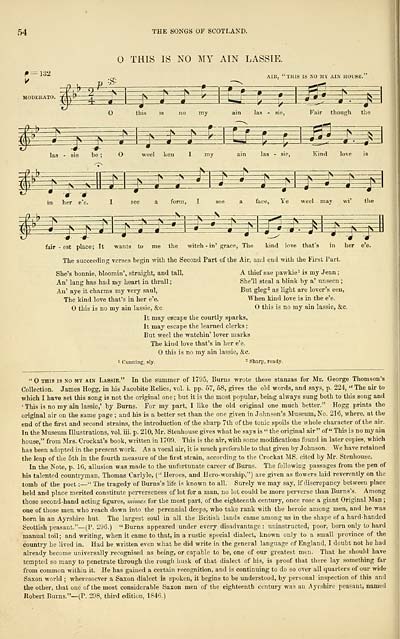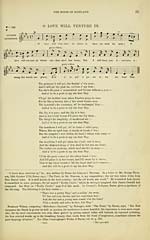Glen Collection of printed music > Printed music > Wood's edition of the songs of Scotland
(78) Page 54 - O this is no my ain lassie
Download files
Complete book:
Individual page:
Thumbnail gallery: Grid view | List view

54
THE SONGS UF SCOTLAND.
THIS IS NO MY AIN LASSIE.
f
V
132
■$■
AIR, " THIS 18 NO MV AIN HOUSE.
MODEKATO.
3E
:zfc
m
this
my
las - sie,
Fair though the
^^^^^^^i^^
las - sie be ;
m
^fpls^
weel ken I my
las - sie,
Kind love is
@^=
in her e'e.
a form, I
face, Ye weel may wi'
the
iSE
3^
U5=^
3EE£ES
^—l—d-v
^=^
kind love that*9
fair - est place; It wants to me the witch - in' grace, The
The succeeding verses begin with the Second Part of the Air, and end with the First Part.
She's bonnie, bloomin', straight, and tall, A thief sae pawkie 1 is my Jean;
An' lang has had my heart in thrall ; She'll steal a blink by a' unseen ;
An' aye it charms my very saul, But gleg 2 as light are lover's een,
The kind love that's in her e'e. When kind love is in the e'e.
this is no my ain lassie, &c. this is no my ain lassie, &o.
It may escape the courtly sparks.
It may escape the learned clerks ;
But weel the watchin' lover marks
The kind love that's in her e'e.
this is no my ain lassie, &c.
i Cunning, isly. ■ Sharp, ready.
-#■ -4-
in her e'e.
" this is no my ain Lassie." In the summer of 1795, Burns wrote these stanzas for Mr. George Thomson's
Collection. James Hogg, in his Jacobite Relics, vol. i. pp. 57, 58, gives the old words, and says, p. 224, " The air to
which I have set this song is not the original one ; but it is the most popular, being always sung both to this song and
' This is no my ain lassie,' by Burns. For my part, I like the old original one much better." Hogg prints the
original air on the same page ; and his is a better set than the one given in Johnson's Museum, No. 216, where, at the
end of the first and second strains, the introduction of the sharp 7th of the tonic spoils the whole character of the air.
In the Museum Illustrations, vol. iii. p. 210, Mr. Stenhouse gives what he says is " the original air" of" This is no my ain
house," from Mrs. Crockat's book, written in 1709. This is the air, with some modifications found in later copies, which
has been adopted in the present work. Asa vocal air, it is much preferable to that given by Johnson. We have retained
the leap of the 5th in the fourth measure of the first strain, according to the Crockat MS. cited by Mr. Stenhouse.
In the Note, p. 16, allusion was made to the unfortunate career of Burns. The following passages from the pen of
his talented countryman, Thomas Carlyle, (" Heroes, and Hero-worship,") are given as flowers laid reverently on the
tomb of the poet :— " The tragedy of Burns's life is known to all. Surely we may say, if discrepancy between place
held and place merited constitute perverseness of lot for a man, no lot could be more perverse than Burns's. Among
those second-hand acting figures, mimes for the most part, of the eighteenth century, once rose a giant Original Man ;
one of those men who reach down into the perennial deeps, who take rank with the heroic among men, and he was
born in an Ayrshire hut. The largest soul in all the British lands came among us in the shape of a hard-handed
Scottish peasant." — (P. 296.) " Burns appeared under every disadvantage : uninstructed, poor, born only to hard
manual toil; and writing, when it came to that, in a rustic special dialect, known only to a small province of the
country he lived in. Had he written even what he did write in the general language of England, I doubt not he had
already become universally recognised as being, or capable to be, one of our greatest men. That he should have
tempted so many to penetrate through the rough husk of that dialect of his, is proof that there lay something far
from common within it. He has gained a certain recognition, and is continuing to do so over all quarters of our wide
Saxon world ; wheresoever a Saxon dialect is spoken, it begins to be understood, by personal inspection of this and
the other, that one of the most considerable Saxon men of the eighteenth century was an Ayrshire peasant, named
Robert Burns."— (P. 298, third edition, 1846.)
THE SONGS UF SCOTLAND.
THIS IS NO MY AIN LASSIE.
f
V
132
■$■
AIR, " THIS 18 NO MV AIN HOUSE.
MODEKATO.
3E
:zfc
m
this
my
las - sie,
Fair though the
^^^^^^^i^^
las - sie be ;
m
^fpls^
weel ken I my
las - sie,
Kind love is
@^=
in her e'e.
a form, I
face, Ye weel may wi'
the
iSE
3^
U5=^
3EE£ES
^—l—d-v
^=^
kind love that*9
fair - est place; It wants to me the witch - in' grace, The
The succeeding verses begin with the Second Part of the Air, and end with the First Part.
She's bonnie, bloomin', straight, and tall, A thief sae pawkie 1 is my Jean;
An' lang has had my heart in thrall ; She'll steal a blink by a' unseen ;
An' aye it charms my very saul, But gleg 2 as light are lover's een,
The kind love that's in her e'e. When kind love is in the e'e.
this is no my ain lassie, &c. this is no my ain lassie, &o.
It may escape the courtly sparks.
It may escape the learned clerks ;
But weel the watchin' lover marks
The kind love that's in her e'e.
this is no my ain lassie, &c.
i Cunning, isly. ■ Sharp, ready.
-#■ -4-
in her e'e.
" this is no my ain Lassie." In the summer of 1795, Burns wrote these stanzas for Mr. George Thomson's
Collection. James Hogg, in his Jacobite Relics, vol. i. pp. 57, 58, gives the old words, and says, p. 224, " The air to
which I have set this song is not the original one ; but it is the most popular, being always sung both to this song and
' This is no my ain lassie,' by Burns. For my part, I like the old original one much better." Hogg prints the
original air on the same page ; and his is a better set than the one given in Johnson's Museum, No. 216, where, at the
end of the first and second strains, the introduction of the sharp 7th of the tonic spoils the whole character of the air.
In the Museum Illustrations, vol. iii. p. 210, Mr. Stenhouse gives what he says is " the original air" of" This is no my ain
house," from Mrs. Crockat's book, written in 1709. This is the air, with some modifications found in later copies, which
has been adopted in the present work. Asa vocal air, it is much preferable to that given by Johnson. We have retained
the leap of the 5th in the fourth measure of the first strain, according to the Crockat MS. cited by Mr. Stenhouse.
In the Note, p. 16, allusion was made to the unfortunate career of Burns. The following passages from the pen of
his talented countryman, Thomas Carlyle, (" Heroes, and Hero-worship,") are given as flowers laid reverently on the
tomb of the poet :— " The tragedy of Burns's life is known to all. Surely we may say, if discrepancy between place
held and place merited constitute perverseness of lot for a man, no lot could be more perverse than Burns's. Among
those second-hand acting figures, mimes for the most part, of the eighteenth century, once rose a giant Original Man ;
one of those men who reach down into the perennial deeps, who take rank with the heroic among men, and he was
born in an Ayrshire hut. The largest soul in all the British lands came among us in the shape of a hard-handed
Scottish peasant." — (P. 296.) " Burns appeared under every disadvantage : uninstructed, poor, born only to hard
manual toil; and writing, when it came to that, in a rustic special dialect, known only to a small province of the
country he lived in. Had he written even what he did write in the general language of England, I doubt not he had
already become universally recognised as being, or capable to be, one of our greatest men. That he should have
tempted so many to penetrate through the rough husk of that dialect of his, is proof that there lay something far
from common within it. He has gained a certain recognition, and is continuing to do so over all quarters of our wide
Saxon world ; wheresoever a Saxon dialect is spoken, it begins to be understood, by personal inspection of this and
the other, that one of the most considerable Saxon men of the eighteenth century was an Ayrshire peasant, named
Robert Burns."— (P. 298, third edition, 1846.)
Set display mode to: Large image | Transcription
Images and transcriptions on this page, including medium image downloads, may be used under the Creative Commons Attribution 4.0 International Licence unless otherwise stated. ![]()
| Special collections of printed music > Glen Collection of printed music > Printed music > Wood's edition of the songs of Scotland > (78) Page 54 - O this is no my ain lassie |
|---|
| Permanent URL | https://digital.nls.uk/91338679 |
|---|
| Description | Scottish songs and music of the 18th and early 19th centuries, including music for the Highland bagpipe. These are selected items from the collection of John Glen (1833 to 1904). Also includes a few manuscripts, some treatises, and other books on the subject. |
|---|
| Description | The Glen Collection and the Inglis Collection represent mainly 18th and 19th century Scottish music, including Scottish songs. The collections of Berlioz and Verdi collected by bibliographer Cecil Hopkinson contain contemporary and later editions of the works of the two composers Berlioz and Verdi. |
|---|

